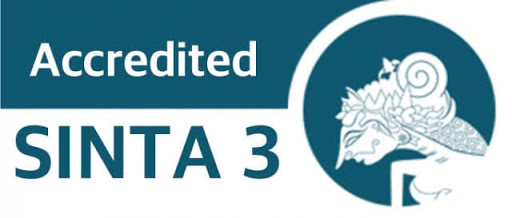IMPROVING STUDENTS ABILITY ON ENGLISH FOR SPECIFIC PURPOSE (ESP) COURSE THROUGH STAR 7 JUMPS MODEL AT COACH STUDY PROGRAM FKIP- UNRI
Abstract
This classroom action research design was aimed at analysing students failure in learning ESP (English for specific purposes) and finding out its solution. The purpose of this study was to improve the ability of Coach Study Program students of FKIP UNRI in learning ESP through STAR 7 Jumps model and to find out factors that contribute more to the improvement. Total 36 students which consisted of 27 boys and 9 girls involved as the participants of the study. This research was done in two cycles. Designing syllabus, evaluating teaching materials, and compiling teaching materials were also the procedures done in each cycle (Planning, action, observation and reflection). Semi-structured observation sheets and field note was used to identify how lecturer teaching and how learners learning and ESP achievement test was employed to identify students ability. The lecturer applied the seven steps of STAR well and it made the students more active, motivated and interested in learning ESP. Students’ ability in learning ESP was also improved where mean pre-test was 67, mean post-test cycle 1 was 73 and mean post-test cycle 2 was 76. The most dominant factor that caused the improvement was the teaching materials about match sports topic by which most students were active in problem identification, brainstorming, analyzing and formulating problems, self-study and presentation.
Keywords
Full Text:
PDF (Bahasa Indonesia)References
Foyewa, R. A. (2015). English: The International Language of Science and Technology. International Journal of English Language and Linguistics Research 3(5) 34-41.
C Sukotjo, K Thammasitboon, H Howell. (2008). Students' Perceptions of Prosthodontics in a PBL Hybrid. Curriculum, Journal of Prosthodontists 17(5) 431-513. doi: 10.1111/j.1532-849X.2008.00323.x
Callison, Daniel. 2015. The Evolution of Inquiry: Controlled, Guided, Modelled, and Free. Colorado: Libraries Unlimited.
DIKTI (2012). Active Learning for Higher Education. Dikti: Jakarta
Erni, E., & Yamat, H. (2014). The Implementation of a Progressive Aproach PBL Model to Improve Students Reading Comprehension at English Study Program FKIP –UR. Ejournal.unp. 2 (2014). 126-136.
Ernie, & Stringer. (2008). Action Research In Education. 2nd Edition. England: Pearson Ed.
Evans-Tony Dudley and John, Maggie Jo. (2012). Development in ESP: A multi-disciplinary approach. Cambridge: Cambridge University Press. 15th printing.
FKIP UNRI. 2014. Kurikulum 2014. Pekanbaru. FKIP- UNRI
Holzer, Siegfried M. and Andruet, Raul H. (2000). Active Learning in the Classroom. Proceedings, ASEE Southeastern Section Annual Meeting, Roanoke. 4. 2-4
Hutchinson, T., and Waters, A. (2010) ESP. A learning centered approach. Cambridge: Cambridge University press. 25th printing
Jeffrey, F., and Nancy, S. (2008). Student-Centered Learning Addressing Faculty Questions about Student-centered Learning. Curriculum, Labor, and Improvement Conference. 30 (11). 1-11.
Kaminskiene, L., and Kavaliauskiene, G. (2014). Attitudes to Improing Speaking Skills by Guided Individual Activities. Journal Santalka: filologija, Edukologija. Central and Eastern European Library. 22 (1). 39-48.
Kavaliauskiene, G. (2005). Task-Based Learning Outcomes in the ESP Classroom. Kalbu studijos Journal in Central and Eastern European Library. 7 ( 2005). 66-70
Mazuardi., Salamuddin, N., & Harun, M., Taib. (2017). Pengaruh Faktor Personal, Interpersonal dan Lingkungan Terhadap Penglibatan Aktifitas Fizik Sekolah Menegah Atas Pekanbaru. Jurnal Sultan Alauddin Sulaiman Shah 4 (2). 44-51.
Mazuardi. (2017). Pengaruh Faktor Personal, Interpersonal dan Lingkungan Terhadap Penglibatan Aktifitas Fizik Sekolah Menegah Atas Pekanbaru. Disertasi. UKM. Malaysia
Nunan, D. (1989). Syllabus Design. Oxford: Oxford University Press.
Priyatmojo, Achmadi,. dkk. (2010). Buku Panduan Pelaksanaan Student Centered Learning (SCL) dan Student Teacher Aesthethic Role-Sharing (STAR). Yogyakarta: Pusat Pengembangan Pendidikan UGM Press.
Sample, A. (2000). Learning theories and their influence on the development and use of educational technologies. Australian Science Teachers Journal, 46(3).
Stringer, E. (2008). Action Research In Education. 2nd Edition. London: Pearson New International Edition.
Valle, B. A. (2019). ESP: Today. Journal of English for Specific Purposes at Tertiary Level. 7 (2). 123-303
Valle, Bocanegra Ana .et.al ( 2007) ESP: Studiea foe Classroom Development and Implementation. UCA: Universided de Cadiz. Primera ediction.
Woolfolk, A. (1998). Educational Psychology Six Edition. A Simon Height Company: Boston.
DOI: http://dx.doi.org/10.33578/pjr.v4i1.7920
Refbacks
- There are currently no refbacks.
Copyright (c) 2020 JURNAL PAJAR (Pendidikan dan Pengajaran)

This work is licensed under a Creative Commons Attribution-NonCommercial-ShareAlike 4.0 International License.
JURNAL PAJAR (Pendidikan dan Pengajaran)
Secretariat
Program Studi Pendidikan Guru Sekolah Dasar
Gedung B1, FKIP Universitas Riau
Kampus Bina Widya Km. 12,5 Simpang Baru Panam
Pekanbaru Riau Indonesia 28293
e-mail : pajar@ejournal.unri.ac.id



